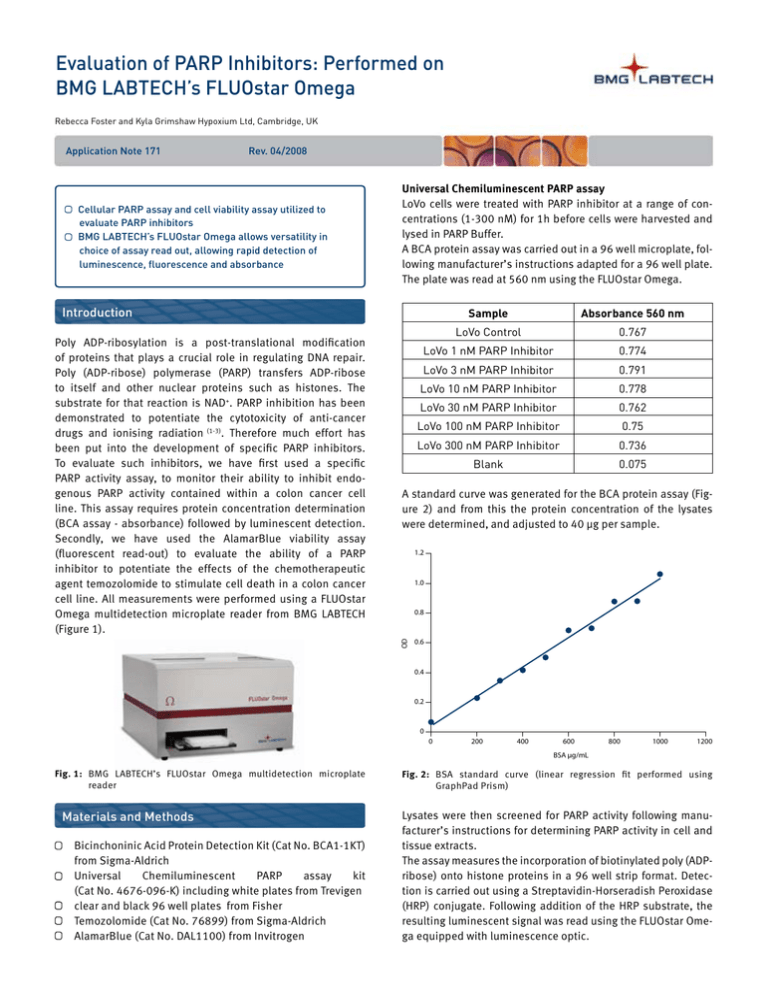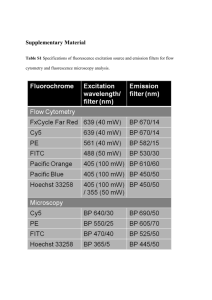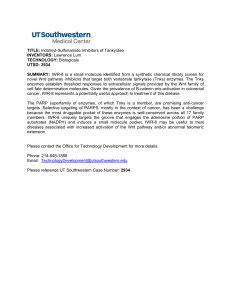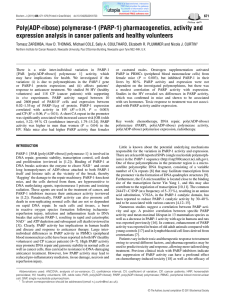Evaluation of PARP Inhibitors
advertisement

Evaluation of PARP Inhibitors: Performed on BMG LABTECH’s FLUOstar Omega Rebecca Foster and Kyla Grimshaw Hypoxium Ltd, Cambridge, UK Application Note 171 Rev. 04/2008 Cellular PARP assay and cell viability assay utilized to evaluate PARP inhibitors BMG LABTECH’s FLUOstar Omega allows versatility in choice of assay read out, allowing rapid detection of luminescence, fluorescence and absorbance Introduction Sample Absorbance 560 nm LoVo Control 0.767 LoVo 1 nM PARP Inhibitor 0.774 LoVo 3 nM PARP Inhibitor 0.791 LoVo 10 nM PARP Inhibitor 0.778 LoVo 30 nM PARP Inhibitor 0.762 LoVo 100 nM PARP Inhibitor 0.75 LoVo 300 nM PARP Inhibitor 0.736 Blank 0.075 A standard curve was generated for the BCA protein assay (Figure 2) and from this the protein concentration of the lysates were determined, and adjusted to 40 µg per sample. 1.2 1.0 0.8 OD Poly ADP-ribosylation is a post-translational modification of proteins that plays a crucial role in regulating DNA repair. Poly (ADP-ribose) polymerase (PARP) transfers ADP-ribose to itself and other nuclear proteins such as histones. The substrate for that reaction is NAD+. PARP inhibition has been demonstrated to potentiate the cytotoxicity of anti-cancer drugs and ionising radiation (1-3). Therefore much effort has been put into the development of specific PARP inhibitors. To evaluate such inhibitors, we have first used a specific PARP activity assay, to monitor their ability to inhibit endogenous PARP activity contained within a colon cancer cell line. This assay requires protein concentration determination (BCA assay - absorbance) followed by luminescent detection. Secondly, we have used the AlamarBlue viability assay (fluorescent read-out) to evaluate the ability of a PARP inhibitor to potentiate the effects of the chemotherapeutic agent temozolomide to stimulate cell death in a colon cancer cell line. All measurements were performed using a FLUOstar Omega multidetection microplate reader from BMG LABTECH (Figure 1). Universal Chemiluminescent PARP assay LoVo cells were treated with PARP inhibitor at a range of concentrations (1-300 nM) for 1h before cells were harvested and lysed in PARP Buffer. A BCA protein assay was carried out in a 96 well microplate, following manufacturer’s instructions adapted for a 96 well plate. The plate was read at 560 nm using the FLUOstar Omega. 0.6 0.4 0.2 0 0 200 400 600 800 1000 1200 BSA µg/mL Fig. 1: BMG LABTECH’s FLUOstar Omega multidetection microplate reader Materials and Methods Bicinchoninic Acid Protein Detection Kit (Cat No. BCA1-1KT) from Sigma-Aldrich Universal Chemiluminescent PARP assay kit (Cat No. 4676-096-K) including white plates from Trevigen clear and black 96 well plates from Fisher Temozolomide (Cat No. 76899) from Sigma-Aldrich AlamarBlue (Cat No. DAL1100) from Invitrogen Fig. 2: BSA standard curve (linear regression fit performed using GraphPad Prism) Lysates were then screened for PARP activity following manufacturer’s instructions for determining PARP activity in cell and tissue extracts. The assay measures the incorporation of biotinylated poly (ADPribose) onto histone proteins in a 96 well strip format. Detection is carried out using a Streptavidin-Horseradish Peroxidase (HRP) conjugate. Following addition of the HRP substrate, the resulting luminescent signal was read using the FLUOstar Omega equipped with luminescence optic. Results and Discussion Universal Chemiluminescent PARP assay Following luminescence measurement, data was analysed using GraphPad Prism (Figure 3). The PARP inhibitor inhibits 50 % PARP activity at a concentration of 14 nM. 100 However, addition of PARP inhibitor in combination with temozolomide, leads to a significant increase in cell death, with an IC50 of 60 µM. This represents >5-fold enhancement of cell death. Temozolomide Alone + PARP inhibitor 100 80 % of control AlamarBlue Viability Assay LoVo cells were seeded in 96 well black plates at 5000 cells per well and allowed to adhere overnight, prior to addition of compound or vehicle control. 0- 300 µM temozolomide was added to cells, with and without 300 nM PARP inhibitor for 72 h. AlamarBlue 10 % (v/v) was then added to cells, and incubated for a further 6 h at 37°C. Live, metabolically active cells convert the AlamarBlue substrate to a fluorescent product, which was then detected using the FLUOstar Omega (Excitation 544 nm and Emisson 590 nm). 60 40 20 0 -6.0 -5.5 -5.0 -4.5 -4.0 -3.5 -3.0 Temozolomide Log [M] % of control 80 Fig. 4: Proliferation Assay performed in LoVo cells treated with Temozo lomide alone, or in combination with 300 nM PARP inhibitor Note: PARP inhibitor alone does not stimulate cell death. 60 Conclusion 40 The ability of the FLUOstar Omega to measure absorbance, luminescence and fluorescence, facilitates simple, rapid measurement of all aspects of our evaluation, using a single machine. 20 0 -9 -8 -7 -6 References PARP Inhibitor Log [M] Fig. 3: Cellular PARP activity in LoVo cells treated with PARP inhibitor for 1h AlamarBlue Proliferation Assay Following measurement of fluorescent product, data was analysed using GraphPad Prism (Figure 4). Temozolomide as a single agent leads to very little cell death, with an IC50 >300 µM. [1]Plummer, E. R. (2006) Inhibition of poly(ADP-ribose) polymerase in cancer. Curr Opin Pharmacol. 6, 364-368. [2]Jagtap and Szabo (2005) Poly(ADP-ribose) polymerase and the therapeutic effects of its inhibitors. Nat Rev Drug Discov. 4, 421- 440. [3]Bryant and Helleday (2004) Poly(ADP-ribose) polymerase inhibitors as potential chemotherapeutic agents. Biochem Soc Trans. 32, 959-961. Germany: BMG LABTECH GmbH Tel: +49 781 96968-0 Australia: France: Japan: UK: USA: Internet: BMG LABTECH Pty. Ltd. BMG LABTECH SARL BMG LABTECH JAPAN Ltd. BMG LABTECH Ltd. BMG LABTECH Inc. Tel: +61 3 59734744 Tel: +33 1 48 86 20 20 Tel: +81 48 647 7217 Tel: +44 1296 336650 Tel: +1 919 806 1735 www.bmglabtech.com info@bmglabtech.com


![Anti-Cleaved PARP antibody [E51] - Cleaved-p25 (DyLight® 488) ab139850](http://s2.studylib.net/store/data/012100636_1-72337847bf9e02b3dae11b5cfb780495-300x300.png)


